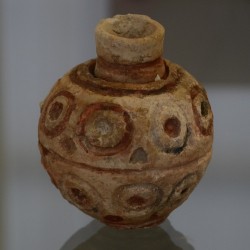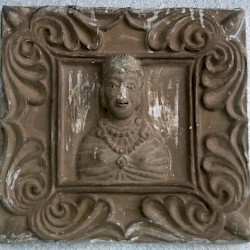Tepe Hesar
Q1484199Tepe Hesar: settlement in northern Iran,south of the Elburz, with finds from the Chalcolithic Age to the Sasanian period.

Tepe Hesar is one of the most famous archaeological sites in Iran. Any traveler coming south from Hyrcania and crossing the Elburz, would reach the Silk Road more or less at this place. Today, the mountain pass is controled by the city of Damghan, which is just five kilometer northwest of Tepe Hesar. This makes the site a logical place to stay, and explains why the area of Tepe Hesar and Damghan has been occupied for a long time.
The site has been identified in 1880 and was excavated in 1925 and 1931-1932, when Reza Shah ordered the construction of the Trans-Iranian Railway, which cuts through the main mound. (That the king was sincerely interested in the archaeological finds is easy to prove: some of them found their way to the Sa'dabad Palace, where they are still on display.)
It was one of the first Chalcolithic and Bronze Age excavations in this area, and the stratigraphy has been very important to date similar sites. In 1976, research was briefly resumed and radiocarbon measures were taken.
The oldest layer, Hesar I, belongs to the Copper Age (Chalcolithicum; after 3800 BCE); it is about as old as Susa B and resembles Sialk III, by which it appears to have been influenced.
There's painted, black-on-buff pottery that was made on a wheel. Stamp seals and nice copper objects have been identified as well.

Hesar II, which starts in about 3600 BCE, is marked by the appearance of burnished grey pottery and the first objects made of bronze. Among the finds are long-shaped bottles.
The next phase, Hesar III, began in about 2800 BCE and saw nice metal work and grey pottery similar to Turan Tepe, which is on the other side of the Elburz. Some three centuries later, when Hesar IIIb ended, a part of the town was violently destroyed. The ruin that is now known as the "Burnt Building", situated in the western part of the hill, is the most recognizable remainder of this catastrophe. Archaeologists have found stone arrowheads and charred battle victims.
The final period, IIIc, lasted until about 1900 BCE. Five moufflon heads made of gold foil were found.
 Bowl from Tepe Hesar I |
 Bottle from Tepe Hesar level II |
 Tepe Hisar, Late Bronze Age phial |
 Damghan, Sasanian relief |
After this period, the site was abandoned and there was a hiatus for about five or six centuries. After about 1350 BCE, people returned and settled on smaller mounds in the neighborhood of the ancient mound. If the main hill was occupied, those recent layers have eroded.

The smaller mounds from the Iron Age and later have not been investigated, although surface finds prove that Tepe Hesar remained inhabited, as one could have expected, because this part of the Silk Road, from Rhagae to Susia, continued to be in use. In the west, the Median kingdom came into being in the second quarter of the first millennium; its armies came along the road and subdued the Parthians. Later, both Media and Parthia were part of the Achaemenid and Seleucid Empires, until the Parthians turned the tables and united Iran. Directly west of Tepe Hesar, Hecatompylos flourished.
Isidore of Charax mentions eight stations along the road in this part of the country, Comisene;note the splendid karavanserail in the west may be a continuation of one of these stations, although it dates to the Sasanian age and was in use during the reign of Kavad I (r.488-530 CE). A palace has been identified in the south. Damghan replaced Tepe Hesar as regional center after the Arab conquest.
That surprises are still possible, was proved during my visit in 2005. We stayed for some time at Tepe Hesar, and someone found a human skull, which we have duly reported to the Iranian archaeological authorities.